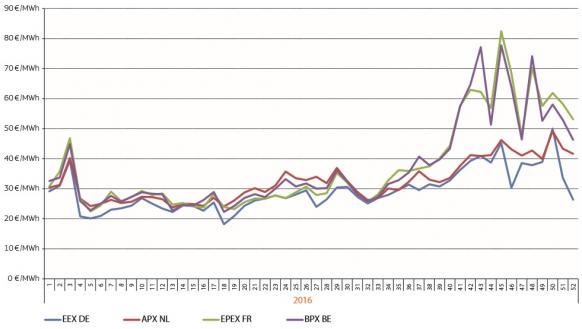US wind costs set to drop 50%; German auction prices slump 25% to equal Spain
Our pick of the latest wind power news you need to know.

Related Articles
Advanced turbines, analytics to cut US onshore wind costs by 50% by 2030
Improvements to U.S. wind farm design and operations are forecast to cut the levelized cost of energy (LCOE) of onshore wind by 50% to $23/MWh by 2030, the National Renewable Energy Laboratory (NREL) said in a new report.
NREL is leading the U.S. Department of Energy’s (DOE’s) Wind Energy Technologies Office Atmosphere to Electrons (A2e) program, which aims to accelerate development in new technologies to enhance power production, lower operations and maintenance (O&M) costs, extend plant life and provide more grid control and reliability features.
NREL has labelled the next generation of wind farm designs as “System Management of Atmospheric Resource through Technology” (SMART) plants.
SMART designs will use advanced energy production estimation tools to optimize designs and incorporate extensive real-time data monitoring to maximize performance, NREL said. Wind power plants will use innovative rotor and drive train technology and more accurate characterization of operational performance at higher hub heights, the research group noted.
Wind farms will also incorporate improved control and dispatch functionality to provide predictable grid support services and adapt to operational requirements for stability and operational planning, it said.
"The resulting SMART wind power plant of the future contains turbines of various sizes each optimized to site-specific plant conditions with advanced technology and significant scaling," NREL said.
Specifically, the new designs could reduce capital expenditures (CAPEX) by 21% through larger turbine scales and other turbine innovations, NREL said.
Annual energy production (AEP) could rise by 22% through turbine scaling and optimal wind plant design and control while operational expenditure (OPEX) could fall by 25% through advanced modelling, sensing and data analytics, the laboratory said.
The new innovations could also extend the lifetimes of wind power plants resulting in a 26% reduction in the cost of capital, it said.
Germany wind auction prices drop 25% to 43 euros/MWh
Germany's second onshore wind power auction in July recorded an average accepted bid price of 43 euros per MWh ($51.2/MWh), some 25% lower than the average price of 57 euros/MWh in the first German wind auction in May, the Bundesnetzagentur regulatory office announced. The latest auction price equals the average price recorded in Spain's 3 GW onshore wind power auction in May.
European average weekly wholesale prices
(Click image to enlarge)
EEX DE represents Germany, APX NL Netherlands, EPEX FR France and BPX BE Belgium.
Source: European Commission's Quarterly Report on European Electricity Markets. Data Source: Platts
Germany allocated 1.0 GW of wind power capacity in the latest auction and 90% of successful bids were from community-owned energy companies, corresponding to 95% of the total volume of accepted bids.
A single company will develop 690 MW of the projects, corresponding to 660 MW of community wind projects and 30 MW of new capacity from other project bidders, the regulatory office said.
Under the auction rules, community projects do not require a permit when they bid and have 54 months to secure the documentation. Community projects are also awarded a price on a "pay as clear" basis while other projects are awarded on a "pay as bid" basis.
Technology advancements continue to raise wind plant efficiencies and international developer E.ON Climate & Renewables has targeted levelized wind power costs below 30 euros/MWh through closer ties with suppliers.
Savings are expected through improved turbine performance and a combination of "Hands-on" operations and maintenance (O&M) relationships, data analytics and smart maintenance efficiencies, Roland Flaig, Head of Wind Operations- Onshore Europe, at E.ON Climate & Renewables, said in February.
"The levelized cost of energy, at least from an E.ON perspective, looks like it could be somewhere around 35 euros/MWh [$37.0/MWh]…That's not really good enough for us, we need to go below 30 [euros]," he said.
In April, DONG Energy and ENBW became the first offshore wind power developers to acquire offshore wind power concessions at unsubsidized prices, bidding prices of zero euros per MWh to build wind farms in German waters.
Dong Energy exports first power from Walney offshore project
MHI Vestas Offshore Wind has installed the first 8 MW turbine at Dong Energy’s 659 MW Walney extension offshore wind farm project and the facility has begun exporting power to the grid on schedule, Dong Energy said in a statement September 4.
The Walney extension project is situated in the Irish Sea,19 km from Cumbria, UK and when completed it will become the world's largest operational offshore wind farm, leapfrogging the 630 MW London Array facility. The Walney extension project will host 87 turbines, 40 of which will be supplied by MHI Vestas and 40 by Siemens Gamesa.
Construction of the project is being co-ordinated from a base at Port of Barrow, UK which already hosts the operating and maintenance teams for DONG Energy's Barrow, Walney and West of Duddon Sands wind farms.
A flurry of UK offshore extension projects has provided developers with a deeper understanding of site challenges, technological gains and economies of scale.
The projects have allowed developers to create synergies between sites, boosting the efficiency of supply chain and vessel sharing operations.
New Energy Update

